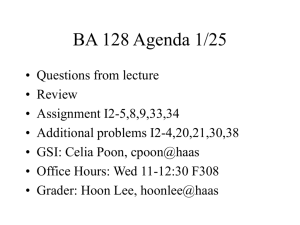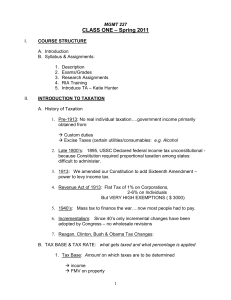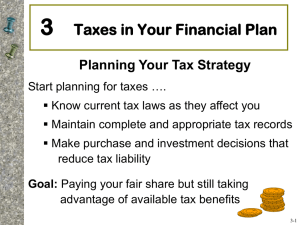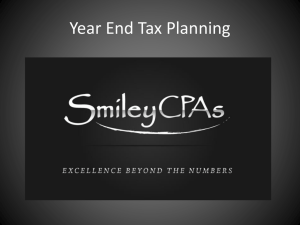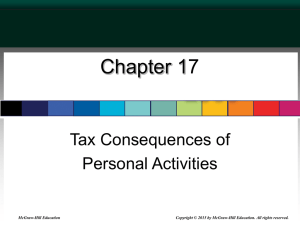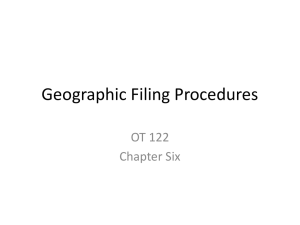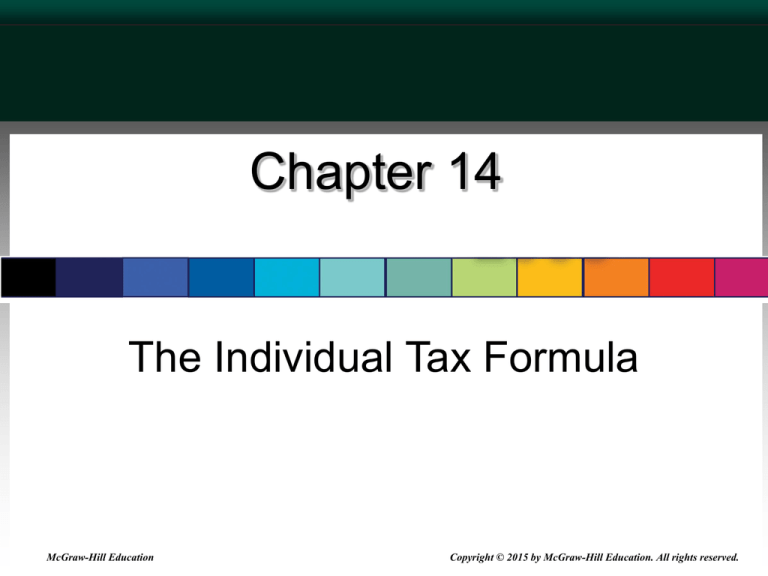
Chapter 14
The Individual Tax Formula
McGraw-Hill Education
Copyright © 2015 by McGraw-Hill Education. All rights reserved.
14-2
Objectives
• Determine an individual’s filing status
• List the four steps for computing individual taxable
income
• Explain the relationship between the standard
deduction and itemized deductions
• Compute an exemption amount
• Compute the regular tax on ordinary income
14-3
Objectives (continued)
• Explain why a marriage penalty exists in the federal
income tax system
• Describe the child credit and dependent care credit
• Recognize circumstances that may trigger the
individual AMT
• Describe the individual tax payment and return filing
requirements
14-4
Filing Status
• Filing status
• Affects calculation of taxable income
• Determines rates at which income is taxed
• Reflects marital and family situation
14-5
Filing Status - Married
• MFJ or MFS if married on the last day of the year
• MFJ (married filing joint) rates
• If spouse incomes are similar, single rates generate
lower overall tax
• If spouse incomes are dissimilar, married rates generate
lower overall tax
• MFJ rates apply to Surviving Spouse status
• A widow/widower with a dependent child for two years
after death of spouse
• MFS (married filing separately) rates are less
favorable than single
14-6
Filing Status - Unmarried
• Head of Household filing status
may be used if the taxpayer
maintains a home for either a:
• Child (need not be dependent), or
• Dependent relative
• Single is the default filing status
for unmarried individuals
14-7
Filing Status Examples
• Determine Mr. J’s filing status in 2014
• Mr. J and Mrs. J were divorced on November 18. Mr. J has not
remarried and has no dependent children
• Mr. J and the first Mrs. J were divorced on April 2. Mr. J remarried the
second Mrs. J on December 15. He has no dependent children
• Mrs. J died on July 23. Mr. J has not remarried and has no
dependent children
• Mrs. J died on October 1, 2013. Mr. J has not remarried and
maintains a home for one dependent child
• Mrs. J died on May 30, 2013. Mr. J has not remarried and has no
dependent children.
• Mr. J and Mrs. J were legally divorced on May 30, 2009. Mr. J has
not remarried and maintains a home for two dependent children.
14-8
Taxable Income Computation
• Step 1: Calculate total income
• Step 2: Calculate adjusted gross income
(AGI)
• Step 3: Subtract itemized deductions or
standard deduction
• Step 4: Subtract exemption amount
14-9
Step One
• Total income includes:
• Salary, wages, fringe benefits
• Net business income
• Income from sole proprietorship
• Income from partnership or S corporation
• Investment income
•
•
•
•
Interest
Dividends
Capital gains
Rental income
14-10
Step Two
• Adjusted gross income (AGI) equals total income
less specific above-the-line deductions
• AGI is an important number because many
deductions and credits are limited by reference
to AGI
14-11
Step Three
• Subtract the greater of:
• Allowable itemized deductions
• Standard deduction
14-12
Standard Deduction (2014)
• Depends on filing status
•
•
•
•
MFJ = $12,400
MFS = $6,200
HOH = $9,100
Single = $6,200
• Blind or age 65 or older
• MJF, MFS = additional $1,200
• HOH or Single = additional $1,550
• Dependent on another return
• Limited to lesser of $1,000 or earned income plus $350
14-13
Itemized Deductions
• See Schedule A (Chapter 17 details)
• Only one-third of individual filers elect to
itemize deductions
• Bunching: if itemized deductions are close to standard
deduction each year, taxpayer should bunch deductions
in alternate years
14-14
Individual Tax Deductions
• Above-the-line deduction always reduces taxable
income
• Itemized deduction may have limited or no effect on
taxable income
• Classification as either above-the-line or itemized
deduction often reflects tax policy and can change
from year to year
14-15
Overall limitation on itemized deductions
• Individuals with AGI in excess of a threshold
amount must reduce total itemized deductions by
3% of excess AGI
• Reduction limited to 80% of total itemized deductions
• Limitation has no effect on standard deduction
• Computation is presented in Appendix 14-A
14-16
Step Four
• Subtract exemption amounts
• Exemption is $3,950 for 2014
• Each taxpayer is allowed a personal exemption
• Two exemptions are allowed for MFJ
• No personal exemption if claimed as
another taxpayer’s dependent
• Taxpayer is allowed a dependency exemption for:
• Qualifying child
• Qualifying relative
14-17
Exemption phaseout
• Individuals with AGI in excess of a threshold
amount must reduce their total exemption amount
by a percentage determined with reference to such
excess
• Phaseout can reduce exemption amount to zero
• Computation is presented in Appendix 14-B
14-18
Summary of Four-step Procedure
Total income
(Above-the-line deductions)
Adjusted gross income (AGI)
(Itemized deductions or
standard deduction)
(Exemption amount)
Taxable income
14-19
Tax Computations
• Calculate 2014 tax on $100,000 taxable income
• MFJ status
$10,162.50 + .25 ($100,000 - $73,800) = $16,712.50
• Single status
18,193.75+ .28 ($100,000 - $89,350) = $21,175.75
14-20
Marriage Penalty Dilemma
• Federal income tax is not marriage neutral
• Limited relief for lower income taxpayers
• 10% and 15% brackets for MFJ are twice that for
singles
• Standard deduction for MFJ is twice that for singles
• Progressive tax system that allows married couples to
file joint returns can be marriage neutral or horizontally
equitable – but not both!
14-21
Kiddie Tax
• Children who earn income in their own name
must file their own tax return
• If child is claimed as a dependent on another
taxpayer’s return:
• Limited standard deduction
• No personal exemption
• Unearned income (in excess of $2,000) of children under
age 18 is taxed at parents’ marginal rate
14-22
Credits
• Child credit = $1,000 per child under age 17
• Phases out for high-income taxpayers
• Dependent care credit for children < 13 years old
or dependents who can’t care for themselves
• Credit is between 35% and 20% of child care costs
depending on AGI
14-23
Credits (con’t)
• Earned income credit is refundable
• Transfer payment to working poor that increases
progressivity of tax rates
• Credit is higher for taxpayers with children and
phases out as AGI increases
• Excess Social Security tax withholding is refunded
as a credit against income tax
14-24
Individual AMTI
• Individuals are subject to AMT on their AMTI in
excess of an exemption
• Exemption amount based on filing status
• AMTI = taxable income +/- AMT adjustments +
preference items
• Positive adjustments include standard deduction and
exemption amount
14-25
AMT Computation
• Tentative minimum tax:
26% on first $182,500 excess AMTI (2014)
28% on additional excess AMTI
• AMT is any excess of tentative AMT over regular
income tax for the year
• Individuals pay both regular income tax and AMT
• Total tax equals tentative minimum tax
14-26
Payment and Filing Requirements
• Income taxes on salaries and wages are withheld
each pay period
• Estimated taxes on self-employment and
investment income are due on April 15, June 15,
September 15, and January 15
14-27
Payment and Filing Requirements
• Underpayment penalty avoided by paying:
• 90% of current year tax
• 100% of prior year tax (110% if AGI > $150,000)
• Form 1040 must be filed by April 15
• Automatic extension until October 15
• Balance of tax due must be paid with extension request
14-28

